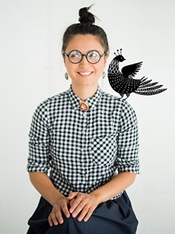Dinara Mirtalipova (b.1982)
Mythical Garden, 2019
Materials: Linoleum block print on 100% cotton paper, edition no. 4/50, 20” x 30”
Location at Summa Health: Dr. Gary B. and Pamela S. Williams Tower on the Akron Campus (141 N. Forge St.), Blue Neighborhood, Fifth Floor Hallway, outside Staff Lounge H5-313
About the Art

Mythical Garden transports us into a vibrant, teeming world where nature and myth intertwine. This bold, single-color print immerses the viewer in a fantastical garden, alive with organic, sinuous forms. The pattern is dense and intricate, as swirling branches, compound leaves, fruit, and flowers create a harmonious, otherworldly atmosphere. At the heart of this garden are whimsical creatures: partridge-like birds perched on branches and a hybrid being with a feline body and bird’s head, adding to the mythical allure.
The design draws on the ancient technique of horror vacui, a decorative style that fills spaces with intricate detail and texture. This approach is a hallmark of traditional Uzbek and Russian metalwork, ceramics, and textiles. The use of this technique allows Mirtalipova to evoke the rich folklore and artistic heritage of her homeland. Each element is deliberately crafted, from the delicate feathers of the birds to the bark of the tree and the body of the hybrid creature, creating a sense of abundance that fills every space in the composition.
About the Artist

Born and raised in Uzbekistan, Dinara Mirtalipova brings the influence of her cultural roots to her work. Initially trained in information technology and cybernetics at Tashkent State University of Economics, Mirtalipova emigrated to the United States as a young adult. She carried with her a deep appreciation for Uzbek and Russian folk art, which she later channeled into a successful career as a designer for American Greetings. Today, she runs her own company, Mirdinara, where she creates textiles, greeting cards, book illustrations, and designs for corporate clients like Moleskine, Netflix, Crate and Barrel, and Anthropologie.
In 2019, Mirtalipova was awarded a residency at Cleveland’s Zygote Press, where she expanded her printmaking practice and explored new directions in this medium. She finds linoleum block printmaking to be an ideal medium for producing both limited edition works and larger quantities of designs, allowing her to celebrate her cultural heritage through bold, joyful imagery.
Where You Can See More of This Artist’s Work
Mirtalipova’s work can be explored further on her website, where she showcases her fine arts prints as well as her commercial designs, including books, greeting cards, and product illustrations. Her work has been featured in exhibitions at the Akron Art Museum, Zygote Press in Cleveland, and the New York Society of Illustrators. She has also exhibited with American Greetings. Notably, she completed a major public art commission in Ohio City, Cleveland: a monumental (635 feet long, 20 feet high) work printed on vinyl mesh that incorporates the same mythical creatures and forms found in her Summa Health print.
